Hello
I want to make and build my first loudspeaker, and I aim to get a more accurate response and accurate sound details from watching movies. Is this work I am building correct or needs to be Modification...
Tweeter :
Dayton Audio RST28F-4 1-1/8" Reference Series Fabric Dome Tweeter 4 Ohm
woofer:
Dayton Audio RS225P-4A 8" Reference Paper Woofer 4 Ohm

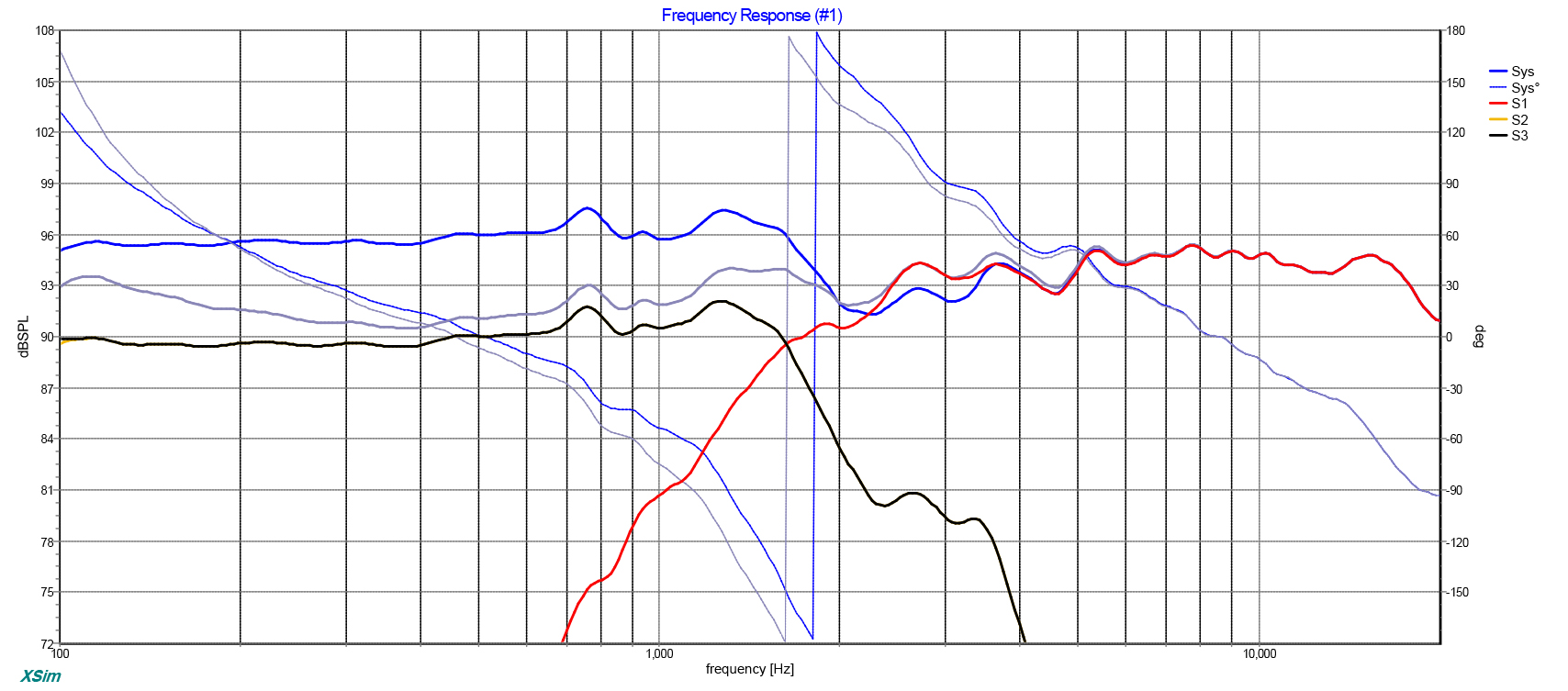
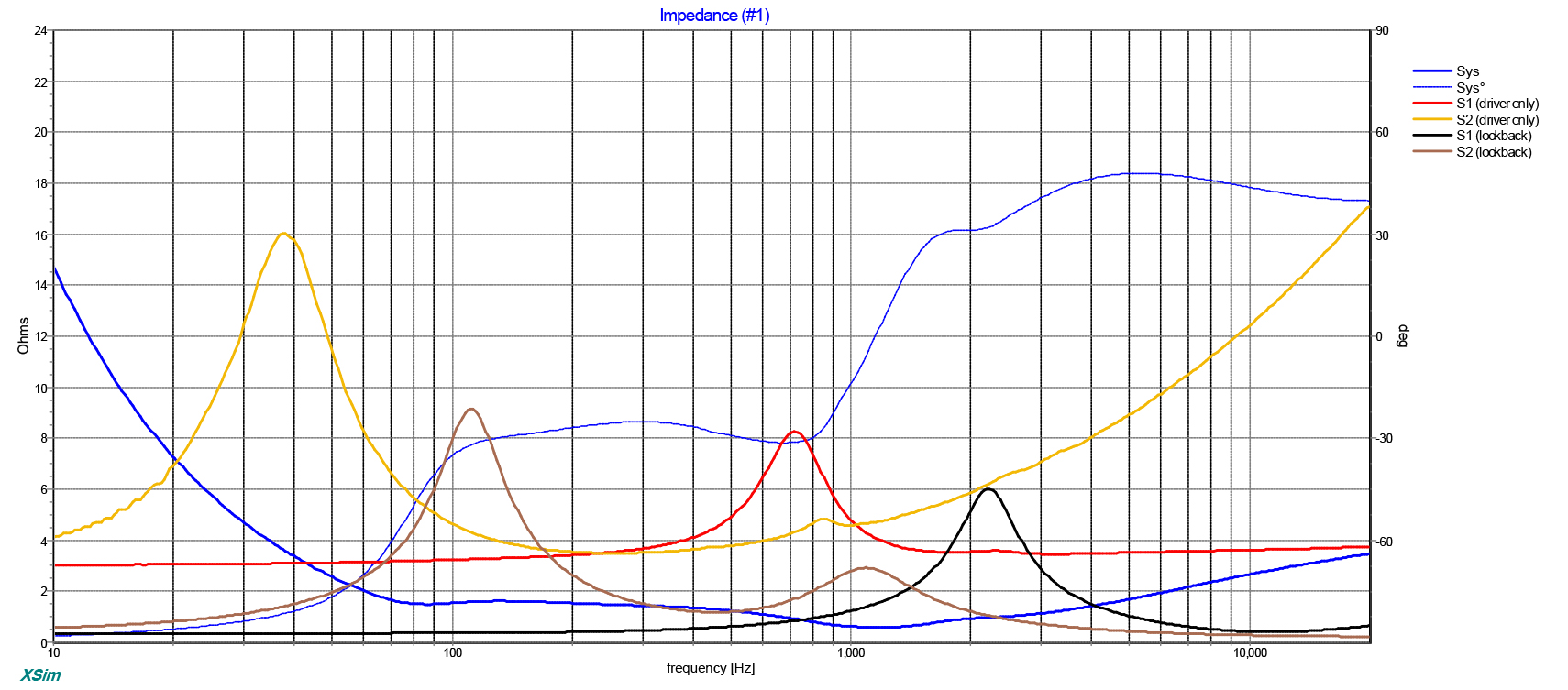
I want to make and build my first loudspeaker, and I aim to get a more accurate response and accurate sound details from watching movies. Is this work I am building correct or needs to be Modification...
Tweeter :
Dayton Audio RST28F-4 1-1/8" Reference Series Fabric Dome Tweeter 4 Ohm
woofer:
Dayton Audio RS225P-4A 8" Reference Paper Woofer 4 Ohm



You might not need a more accurate frequency response.
As people age their brains don't process audio information as well as when they are young. Stereo audio is more difficult for a brain to process, even if it is perfectly flat frequency response.
Watching movies takes a lot of brain power. Most of that power is dedicated to processing the visual content.
To make a movie comfortable and enjoyable to watch you need to be able to understand the dialogue. You can help your brain do that by eliminating stereo. Send all the audio through a single speaker running in mono. It doesn't matter if that speaker is off to the right or left because your brain will re-locate the dialogue onto the mouth of the person speaking on screen. If you want to locate the loudspeaker in the room you have to redirect your attention away from the movie and concentrate on the audio. The more complex solution is to increase the volume of a center channel and reduce the volume of your ambiance surround speakers.
Same thing happens with audio quality. When your brain is occupied watching the movie you don't notice lower quality audio. It's not like sitting in front of a stereo when all your attention is focused on music.
As people age their brains don't process audio information as well as when they are young. Stereo audio is more difficult for a brain to process, even if it is perfectly flat frequency response.
Watching movies takes a lot of brain power. Most of that power is dedicated to processing the visual content.
To make a movie comfortable and enjoyable to watch you need to be able to understand the dialogue. You can help your brain do that by eliminating stereo. Send all the audio through a single speaker running in mono. It doesn't matter if that speaker is off to the right or left because your brain will re-locate the dialogue onto the mouth of the person speaking on screen. If you want to locate the loudspeaker in the room you have to redirect your attention away from the movie and concentrate on the audio. The more complex solution is to increase the volume of a center channel and reduce the volume of your ambiance surround speakers.
Same thing happens with audio quality. When your brain is occupied watching the movie you don't notice lower quality audio. It's not like sitting in front of a stereo when all your attention is focused on music.
I'm afraid there's quite a lot wrong. This is going to be brutal. Sorry.
- L1 is superfluous.
- I have no idea what your low-pass is trying to do, but a cap to ground with barely anything before it will mean your impedance drops low.
- You want to keep the blue curve above about 3.5ohm, without putting resistors in series with the woofers.
- Do not build this crossover. It will melt any amplifier that doesn't have over-current protection.
Take a look at Rod Elliott's articles on passive crossover design for some sensible direction.
Chris
- L1 is superfluous.
- I have no idea what your low-pass is trying to do, but a cap to ground with barely anything before it will mean your impedance drops low.
- You want to keep the blue curve above about 3.5ohm, without putting resistors in series with the woofers.
- Do not build this crossover. It will melt any amplifier that doesn't have over-current protection.
Take a look at Rod Elliott's articles on passive crossover design for some sensible direction.
Chris
Thank you for your response that at the beginning of my education I will take your advice very seriously and will try again
Order a kit by one of the several well respected and experienced designers from either Meniscus Audio, Madisound, Parts Express, or diysoundgroup. Lots of great kits to choose from at all different prices.
You'll get excellent sound quality right from the very beginning. Otherwise, it could be a very long time before you get to that level. If you even get there at all.
You'll get excellent sound quality right from the very beginning. Otherwise, it could be a very long time before you get to that level. If you even get there at all.
Passive Crossover Network Design
try to understand what each component in your crossover is doing, and why the low impedance in your original design will blow up your amplifier
try to understand what each component in your crossover is doing, and why the low impedance in your original design will blow up your amplifier
I highly respect Rod Elliot for his electronics knowledge, but not for speaker design. This article is another one that if followed will led to a bad speaker as it will not take into account natural frequency response of the drivers and any box/baffle effects, and also acoustical path difference. IMHO it is partly good only for educational purpose, for someone that knows nothing, but it is not enough.
The two latter effects are what most novices don't know and thus they simply put infinite wall frd and zma files into XSim and think that the outcome is what XSim is showing. Unfortunately XSim, that I use extensively, is the kind of program that I name GIGO, Garbage In, Garbage out, so in order to have the right outcome you need to provide good input.
As I said here several times, if the approach to DIY speaker building (including the design phase) is to build one shot a speaker that outperforms a comparable priced commercial product, then I'm afraid but it is impossible. You can succeed, maybe, only with enough knowledge and not at your first try. In this approach, it is a hobby where you will put a lot of money and time into it.
If you omit the design phase, the DIY approach can save some money vs the commercial product especially in the higher priced products. Or you can create something visually attractive. So in this case search for a complete kit or simply a speaker plan which comes from a reputable speaker designer.
Ralf
Apart for the bad crossover, you can't expect to have an amp friendly speaker using two 4-Omh woofers in parallel.
The two latter effects are what most novices don't know and thus they simply put infinite wall frd and zma files into XSim and think that the outcome is what XSim is showing. Unfortunately XSim, that I use extensively, is the kind of program that I name GIGO, Garbage In, Garbage out, so in order to have the right outcome you need to provide good input.
As I said here several times, if the approach to DIY speaker building (including the design phase) is to build one shot a speaker that outperforms a comparable priced commercial product, then I'm afraid but it is impossible. You can succeed, maybe, only with enough knowledge and not at your first try. In this approach, it is a hobby where you will put a lot of money and time into it.
If you omit the design phase, the DIY approach can save some money vs the commercial product especially in the higher priced products. Or you can create something visually attractive. So in this case search for a complete kit or simply a speaker plan which comes from a reputable speaker designer.
Ralf
Apart for the bad crossover, you can't expect to have an amp friendly speaker using two 4-Omh woofers in parallel.
The comments regarding passive crossover complexity indicate new DIYers should steer clear of passive crossovers, even in kits. There's no future in passive DIY so there's no value in learning the skill unless you intend to build speakers for sale to the general public. Instead, learn DSP+individual amplification. Digital signals will continue to get better and cheaper. Further, it isn't cheap to buy commercial speakers intended for DSP + individual amplification so DIY makes sense.
However, the context here is watching movies. DIYing a speaker to *improve accuracy* for watching movies triggers my Spidey-sense.
However, the context here is watching movies. DIYing a speaker to *improve accuracy* for watching movies triggers my Spidey-sense.
The comments regarding passive crossover complexity indicate new DIYers should steer clear of passive crossovers, even in kits. There's no future in passive DIY so there's no value in learning the skill unless you intend to build speakers for sale to the general public. Instead, learn DSP+individual amplification. Digital signals will continue to get better and cheaper. Further, it isn't cheap to buy commercial speakers intended for DSP + individual amplification so DIY makes sense.
However, the context here is watching movies. DIYing a speaker to *improve accuracy* for watching movies triggers my Spidey-sense.
This is the same nonsense that you tried to promote in another thread. There are great sounding DIY designs with passive crossovers that are easy to build and enjoy. For the majority of DIYers this is still the best way to go.
Active designs with DSP, multiple amplifiers, and multiple DACS are complicated and very expensive to build if you use quality components. So instead you advocate using cheap, crappy amplifiers and DACs. No thank you. I think for most of us sound quality is at or near the top of list. Not the bottom.
The comments regarding passive crossover complexity indicate new DIYers should steer clear of passive crossovers, even in kits. There's no future in passive DIY so there's no value in learning the skill unless you intend to build speakers for sale to the general public.
Sorry, I have to raise the "bovine manure" flag at that statement. I just completed a high performance active system, and I love it. Best system I have ever had. Perhaps the best system I have ever heard. But passive speaker systems are far from dead, and easily outnumber active speaker systems 100 to 1. I also just completed a neat little 2 way with a passive crossover and it was great fun and it sounds great considering the low cost.
A person new to speaker design can choose to go active or passive, and either is a very valid choice and both can lead to great sound.
I thank you all for your participation. When I was asked, so I know where the mistake is. Should I continue or stand until I correct the project in general, and from all of you we benefit. I agree with you, my friend (hifi jim). The fun is that a person tries to fail the first time, but the important thing is that in the end he succeeds and has special pleasure When you implement a project with your own hands
In this case it would be better to adjust the crossover before you try it, even if you are planning to keep tuning by ear.Should I continue or stand until I correct the project in general,
In addition to the advice given above, you could post your Xsim project file and someone might show you.. your call.
Hi Khaled258,
I say "Go for it", stick with your project and drivers.
Go back to the simulation, for the bass stick in 1.5mh (0.5ohm) in series and maybe 6 to 8 uf in parallel with the driver.
Now for the tweeter i am guessing 10uf in series and 250mH in parallel. followed by 3 ohm in series to the tweeter and maybe 8 ohm in parallel with the tweeter. What does the result look like. Probably pants. But it should be a basic start.
Check the impedance you don't want it to fall below 4 ohms, and try to get a gently sloping down or at least flatish response. What happens when you flip the tweeter polarity. Play with the values one at a time to see what happens. You may also need to think about driver offsets and distances etc to get a more accurate simulation. Just play for now and get a feel for how things interact.
Post your results and others will comment I am sure.
If your choice of drivers is used in a kit I would suggest you use the same size dimensions as the kit cabinet to give you a starting point.
I say "Go for it", stick with your project and drivers.
Go back to the simulation, for the bass stick in 1.5mh (0.5ohm) in series and maybe 6 to 8 uf in parallel with the driver.
Now for the tweeter i am guessing 10uf in series and 250mH in parallel. followed by 3 ohm in series to the tweeter and maybe 8 ohm in parallel with the tweeter. What does the result look like. Probably pants. But it should be a basic start.
Check the impedance you don't want it to fall below 4 ohms, and try to get a gently sloping down or at least flatish response. What happens when you flip the tweeter polarity. Play with the values one at a time to see what happens. You may also need to think about driver offsets and distances etc to get a more accurate simulation. Just play for now and get a feel for how things interact.
Post your results and others will comment I am sure.
If your choice of drivers is used in a kit I would suggest you use the same size dimensions as the kit cabinet to give you a starting point.
Last edited:
DSP is just a way to sell mentally lazy people more electronic junk they don't need
Well said, my passive-using friend!
May I show this quote other places?
Wolf
Khaled258, here's a couple of 8" plus 1" designs:
Seas Njord:
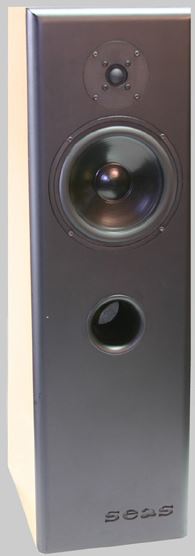
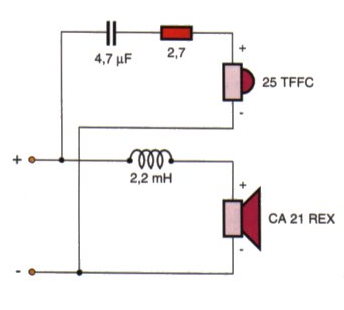
Monitor Audio R300-MD:
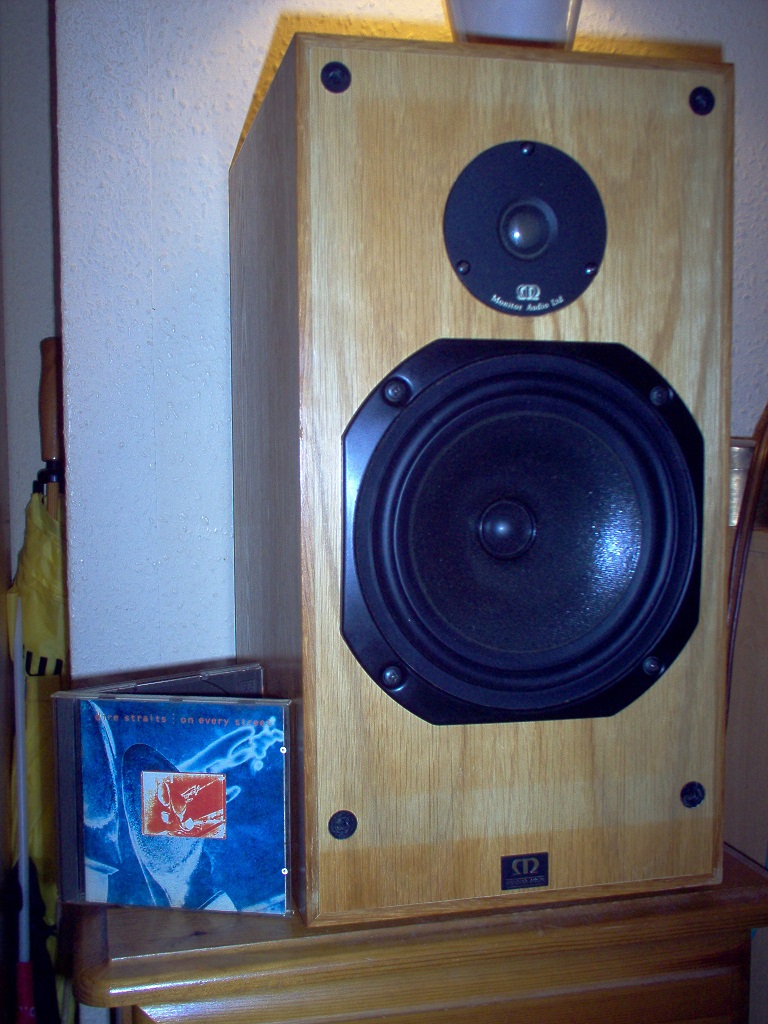
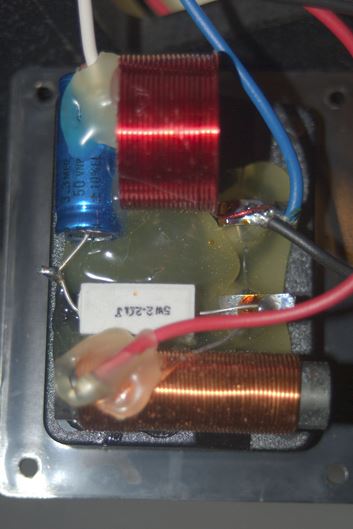
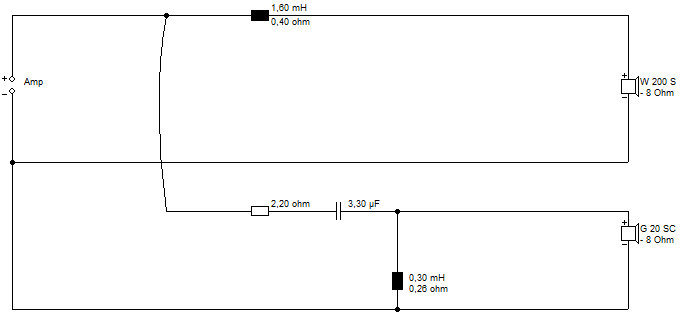
Both using 8 ohm drivers. Much better idea than your two 4 ohm ones:
Dayton Audio RS225P-4A 8" Reference Paper Woofer 4 Ohm
Dayton Audio RST28F-4 1-1/8" Reference Series Fabric Dome Tweeter 4 Ohm
Hope it helps. 4 ohm drivers are a very silly idea. The woofer you fancy is a bit of a nightmare too.
Seas Njord:
Monitor Audio R300-MD:
Both using 8 ohm drivers. Much better idea than your two 4 ohm ones:
Dayton Audio RS225P-4A 8" Reference Paper Woofer 4 Ohm
Dayton Audio RST28F-4 1-1/8" Reference Series Fabric Dome Tweeter 4 Ohm
Hope it helps. 4 ohm drivers are a very silly idea. The woofer you fancy is a bit of a nightmare too.
- Home
- Loudspeakers
- Multi-Way
- 2-way build